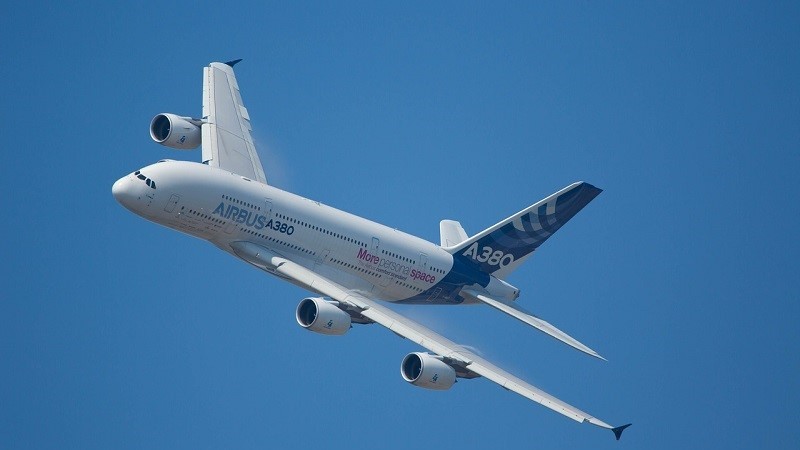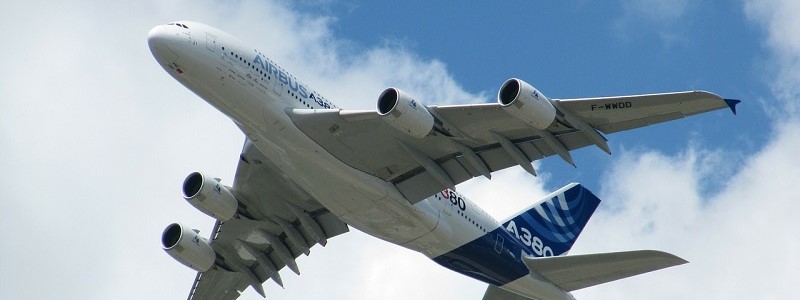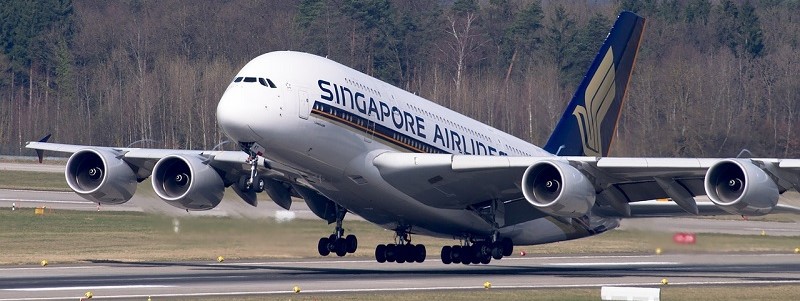

It’s a rumour that’s been circulating the aerospace industry for a little while now but it looks like the Airbus A380 will officially be discontinued in 2021.
The news follows the decision by Emirates to reduce its order from 162 to 123 aircraft.
The new deal worth $21.4 billion will see another 14 A380s built and the rest of the order will be made up of A330 and A350 planes instead.
The Airbus chief executive was quoted by The Independent as saying:
“As a result of this decision we have no substantial A380 backlog and hence no basis to sustain production, despite all our sales efforts with other airlines in recent years.
“This leads to the end of A380 deliveries in 2021.”
It’s a disappointment for the European airline manufacturer who hailed the A380 as a revolution in commercial flight.
And with good reason.
The A380 is the biggest commercial airliner ever made. With a length of 73m, a wingspan of 80m and 5,920 square feet of usable floor space, it’s a beast. And 40% bigger than the Boeing 747-8.
It’s so big that the narrower top deck – that runs the length of the aircraft – is the same width as other wide-body aircraft.
With a range of 8,500 nautical miles and a top speed of 561 miles per hour, it was no slouch either.
So what went wrong?

The genesis of what would become the A380 began in the late 80s in an effort by Airbus to break Boeing’s hold over the long haul market.
This led to a decade’s long research and development project. Including a short lived joint feasibility study with Boeing. However Boeing pulled out as they believed the projected $15 billion in development costs wouldn’t be worth it.
In 2000 the A3XX project launched in earnest to a projected development budget of $9.5 billion. However it was plagued by delays, technical issues and logistical headaches. Despite the first plane rolling off the production line 2007, development continued for a further 8 years.
Costs ballooned. Depending on who you believe the final development costs were around $20-25 billion. Although Airbus themselves claim they were closer to $15 billion.
Add in the specialist nature of the A380 and the $445.6 million price tag meant they needed to sell volume in order to make it a viable member of the Airbus family.
After initial interest from British Airways, Singapore Airlines and others, interest quickly dried up. A spark of hope was revived when Emirates invested heavily thanks to their emphasis on luxury air travel. They initially placed an order for 160 A380s. Although this has since been revised to 123, of which 109 have been delivered.
Airbus received 313 orders in total of which 234 were delivered, falling well short of profitability.
This is in stark contrast to Airbus’ belief that demand would be around 1,200 planes back in 2000 when the project began. That number was revised to 700 upon launch.
But they never could have predicted the 2008/9 economic crash and all the other economic upheaval that has hit holiday makers and businesses in the years since.
With components made in the United Kingdom, France, Germany and Spain the logistics of construction are mind boggling.
Assembly is carried out in Toulouse, France which resulted in components having to be shipped by specialist road and water transports.
A dedicated fleet of roll-on/roll-off ferries and barges were commissioned along with port facilities in order to accommodate the size of the A380 components.
The ambition of the A380, not just as a piece of engineering but as an endeavour is staggering.
However, despite a sizeable investment and 313 total orders the aircraft has put a €463 million dent in Airbus’ bottom line, according to the Washing Post.
Airbus has reported net profit of €3.1 billion (a 29% increase on the previous year). But considering the cost of the aircraft (compared to profit) and the declining production rates, it’s clear that the A380 is no longer viable.
Halting production now makes complete financial sense for the European aerospace giant. It’s just another technological backwards step in the aerospace industry.
Airbus has promised its customers ongoing technical support for the life of the planes so we can expect to see the A380 plying the skies for the next few years.
However the second hand value of the A380 has operators nervous. In 2017 Singapore Airlines were forced to sell two of their A380s for parts after just 10 years of service.

With mounting pressure from consumers to provide better service at lower prices, affected air operators will have to manage their fleets very carefully to avoid being lumbered with a white elephant.
With carriers in the second hand market weighing up the bargain basement price against what their customers expect, there’s a real chance that other carriers will follow in Singapore Airline’s footsteps.
How long Airbus is willing to support the A380 for will likely have an impact on the plane’s value too.
The news will be a disappointment to many – not least of all Airbus. But with considerable research going into advanced materials to reduce weight, noise and drag perhaps the future of mass conveyance isn’t size.
The likes of NASA and Boeing are actively developing the next generation of supersonic engines and aircraft. So the next step in commercial flight will likely be smaller high speed, high efficiency and low emission aircraft.
It’s a hot topic for sure with many criticising the A380 for its high emissions.
Airbus claimed a fully loaded A380 with all 525 seats full produces 75g of CO2 per customer per mile. Although independent data suggests – due to differing configurations and the planes often taking off under subscribed – number is much higher. Around 106-109g per customer per mile.
In comparison the much older Boeing 747-8 which produces around 88g per customer per mile.
It’s worth noting that the engines mounted on the A380 are designed to use less than 3 litres of fuel per 100 passenger kilometres. This is roughly the same level of fuel efficiency as the average modern compact car.
It remains to be seen what Airbus will do next. Presumably, concentrate their efforts behind their successful A330 and A350 ranges.
There is, of course, a human cost to the halt in production. Early estimates suggest that 3,500 jobs are now at risk.
It’s too early to tell whether or not those individuals will be absorbed into the increased production of the other models but we wish them all the best.
Although it’s hard not be excited about the innovations happening within the aerospace industry, it’s always sad when something as ground breaking as the Airbus A380 gets consigned to the history books.
At least we will still see them taking to the skies for a little while longer.
If you have been affected by the events unfolding at Airbus we may be able to support you. Get in touch today to speak to one of our consultants or click here to upload your CV.